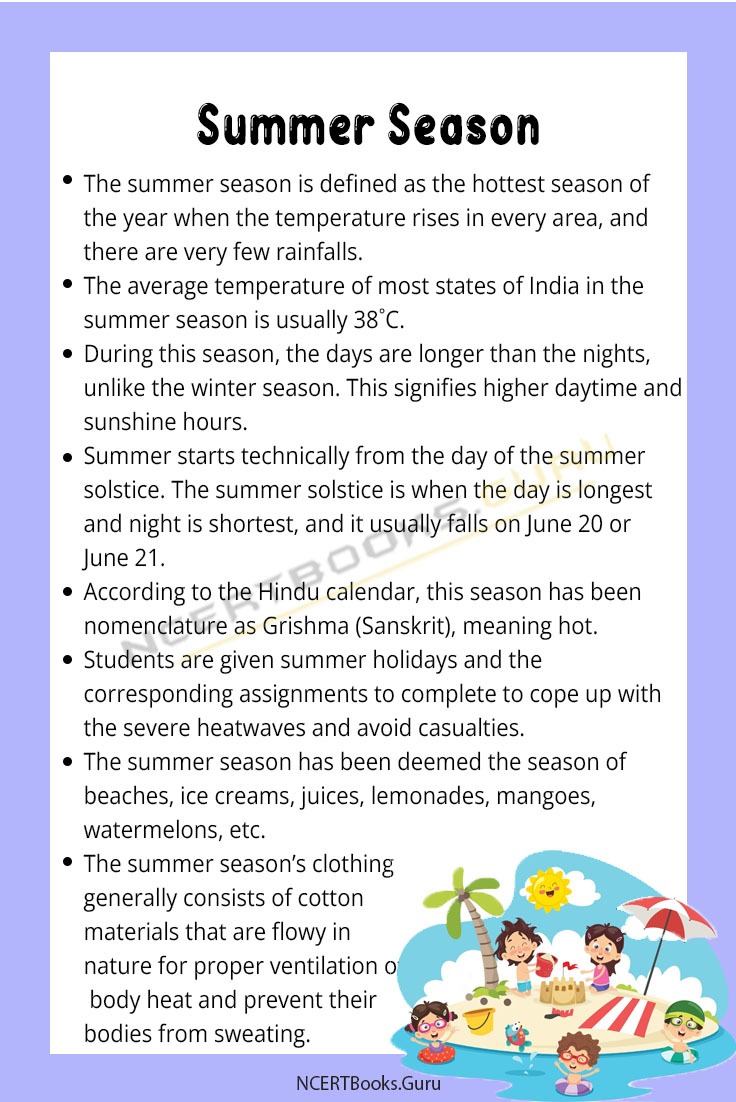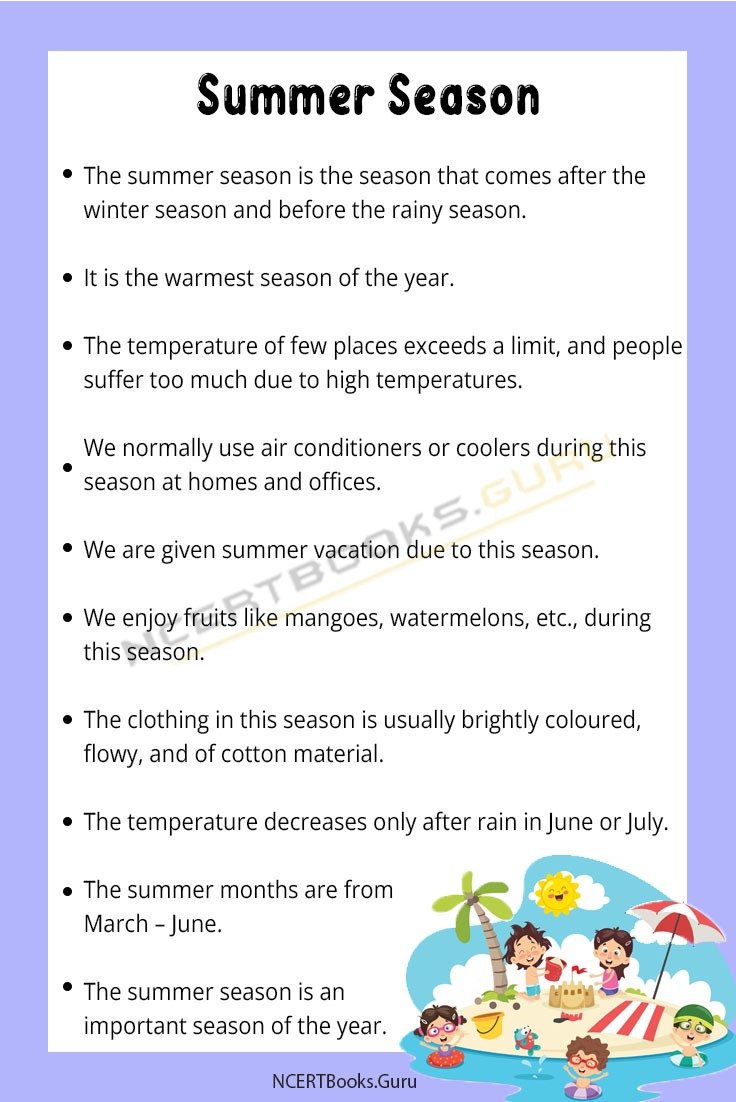10 Lines on Summer Season: The summer season is defined as the hottest season of the year when the temperature rises in every area, and there are very few rainfalls. Technically, the summer season follows the spring season and is followed by the monsoon season. During this season, the days are longer than the nights, unlike the winter season.
This signifies higher daytime and sunshine hours. Summer starts technically from the day of the summer solstice. The summer solstice is when the day is longest and night is shortest, and it usually falls on June 20 or June 21.
Enhance your vocabulary and writing skills with 10 Lines Essays available. Spark up the creativity in you and access various Topics on 10 Lines all in one place.
Set 1 – 10 Lines on Summer Season for kids
Set 1 is helpful for students of Classes 1, 2, 3, 4 and 5.
- The summer season is the season that comes after the winter season and before the rainy season.
- It is the warmest season of the year.
- The temperature of few places exceeds a limit, and people suffer too much due to high temperatures.
- We normally use air conditioners or coolers during this season at homes and offices.
- We are given summer vacation due to this season.
- We enjoy fruits like mangoes, watermelons, etc., during this season.
- The clothing in this season is usually brightly coloured, flowy, and of cotton material.
- The temperature decreases only after rain in June or July.
- The summer months are from March to June.
- The summer season is an important season of the year.

Set 2 – 10 Lines on Summer Season for School Children
Set 2 is helpful for students of Classes 6, 7 and 8.
- The summer season is defined as the hottest season of the year when the temperature rises in every area, and there are very few rainfalls.
- Technically, the summer season follows the spring season and is followed by the monsoon season.
- The average temperature of most states of India in the summer season is usually 38˚C.
- During this season, the days are longer than the nights, unlike the winter season.
- Students are given summer holidays and the corresponding assignments to complete to cope up with the severe heatwaves and avoid casualties.
- The delicacies of summer vacation range from mangoes, watermelons to ice creams and cold drinks.
- The severe unbearable temperatures are made somewhat easier to tolerate with modern equipment like air conditioners, cooler, etc.
- People prefer cotton materials that are flowy in nature for proper ventilation of body heat and prevent their bodies from sweating. Sleeveless and short sleeves dress style is mostly preferred. Bright coloured clothing is advised as bright colour reflects most of the light that falls on it rather than absorbing it, thus keeping the body cooler than it would have been in dark-hued clothes.
- Summer is the season of many festivals and celebrations and is important for many crops that thrive in our country like rice, maize, etc.
- Besides being the hottest month of the year, summer is still a lovable season due to the time-bound delicacies that appear during summer, summer holidays, etc.
Set 3 – 10 Lines on Summer Season for Higher Class Students
Set 3 is helpful for students of Classes 9, 10, 11, 12 and Competitive Exams.
- The summer season is defined as the hottest season of the year when the temperature rises in every area, and there are very few rainfalls. Technically, the summer season follows the spring season and is followed by the monsoon season.
- The average temperature of most states of India in the summer season is usually 38˚C.
- During this season, the days are longer than the nights, unlike the winter season. This signifies higher daytime and sunshine hours.
- Summer starts technically from the day of the summer solstice. The summer solstice is when the day is longest and night is shortest, and it usually falls on June 20 or June 21.
- According to the Hindu calendar, this season has been nomenclature as Grishma (Sanskrit), meaning hot. The season is also referred to as Zaid in agricultural terminologies by farmers.
- Students are given summer holidays and the corresponding assignments to complete to cope up with the severe heatwaves and avoid casualties. Students without heavy occupying curriculum are given assignments based on creativity that make them think outside the box. Students of higher standards are given tasks related to their curriculum to help them build up their calibre.
- The summer season has been deemed the season of beaches, ice creams, juices, lemonades, mangoes, watermelons, etc. These are the most preferred delicacies in summer.
- The summer season’s clothing generally consists of cotton materials that are flowy in nature for proper ventilation of body heat and prevent their bodies from sweating. Sleeveless and short sleeves dress style is mostly preferred. Bright coloured clothing is advised as bright colour reflects most of the light that falls on it rather than absorbing it, thus keeping the body cooler than it would have been in dark-hued clothes.
- The summer season is geographically important as it produces the driving force that attracts monsoon winds onto the landmass and is also agriculturally important.
- Thus, summer is loved by students, parents, office employees, farmers, etc., owing to its several merits.

Frequently Asked Questions on Summer Season
Question 1.
What is summer equinox?
Answer:
Summer equinox is the longest day of the year, which marks the beginning of summer.
Question 2.
What are some summer season crops?
Answer:
There are many crops in the summer season, out of which tomato, cucumber, rice, maize, etc., are the major crops.
